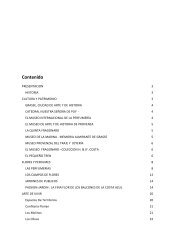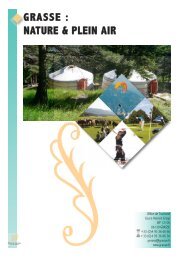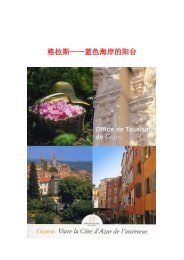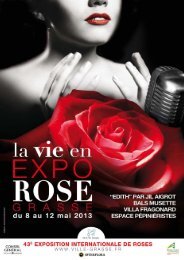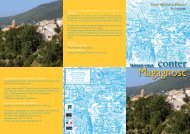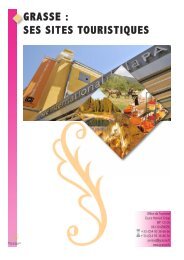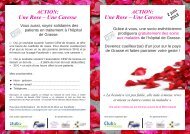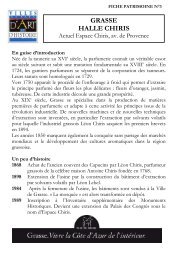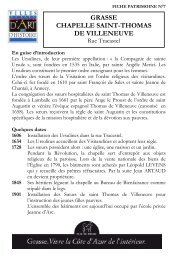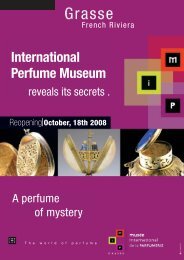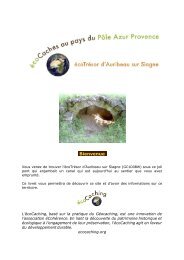dossier de presse
dossier de presse
dossier de presse
You also want an ePaper? Increase the reach of your titles
YUMPU automatically turns print PDFs into web optimized ePapers that Google loves.
Hélène et Jean-François Costa,<br />
hommage a <strong>de</strong>ux collectionneurs<br />
L’amour les unissait, la passion du beau les faisait<br />
vibrer. Au fil <strong>de</strong>s années, chacun a bâti <strong>de</strong>s collections<br />
qui sont <strong>de</strong>s références internationales<br />
dans leurs domaines. Hélène a réuni tissus, bijoux<br />
et costumes provençaux anciens, quant à<br />
Jean-François, sa passion était le XVIIIe siècle.<br />
La Maison Fragonard inaugure trois nouvelles<br />
expositions du 18 avril au 31 décembre 2013 :<br />
> "Conversation piece" <strong>de</strong> Carolyn Quartermaine /<br />
Musée Fragonard<br />
> La Fontaine & Fragonard : Contes et <strong>de</strong>ssins /<br />
Musée Fragonard<br />
> Hélène Costa, la Provence pour passion /<br />
Musée Provençal du Costume
conversation Piece scEnes <strong>de</strong> genre)<br />
la Maison Fragonard<br />
donne Carte blanChe<br />
à Carolyn QuarterMaine<br />
Ouvrant la voie à une nouvelle direction pour<br />
le Musée Jean-Honoré Fragonard à Grasse, la<br />
famille Costa a invité Carolyn Quartermaine<br />
pour la réalisation d'une exposition d'art<br />
contemporain. Cette exposition retrace les<br />
passions d’un couple hors du commun et nous<br />
offre à découvrir l’histoire <strong>de</strong> cette entreprise<br />
familiale profondément ancrée dans le pays<br />
grassois.<br />
Carolyn Quartermaine a posé son regard<br />
sur les archives <strong>de</strong> la famille : photographies<br />
anciennes, <strong>de</strong>ssins mais également objets <strong>de</strong> la<br />
parfumerie Fragonard, documents, étiquettes,<br />
pour tisser une chronologie en hommage<br />
à Jean-François et Hélène Costa. Cette<br />
installation <strong>de</strong> collages<br />
forme une composition poétique intuitive dirigée<br />
par le seul sens esthétique et émotionnel.<br />
Souvenirs, mémoire, entre vie publique et vie<br />
privée, elle nous fait plonger dans un univers<br />
artistique qui touche à l’intime.<br />
the house oF Fragonard<br />
giVes Carte blanChe<br />
to Carolyn QuarterMaine<br />
In a new <strong>de</strong>parture for the Jean-Honoré<br />
Fragonard Museum in Grasse, the Costa<br />
family invited Carolyn Quartermaine to curate<br />
a contemporary exhibition. This exhibition<br />
traces the passion of an extraordinary couple,<br />
giving us an insight into a family business<br />
<strong>de</strong>eply rooted in Grasse soil.<br />
Carolyn Quartermaine looked into the family<br />
archives, including old photographs and<br />
drawings, items from the Fragonard perfumery<br />
house, documents and labels, to compile a<br />
story in homage to Jean-Francois and Hélène<br />
Costa.<br />
This collage installation takes the form of<br />
an intuitive poetical composition driven by<br />
aesthetic and emotional sensibilities. Souvenirs,<br />
memories, from private and public life, plunge<br />
us into an artistic universe that touches upon<br />
the intimacy of a family.<br />
Jean-François Costa (1921-2012)<br />
La maison Fragonard est fondée à Grasse<br />
en 1926. Jean-François Costa (sur la photo)<br />
développe l’entreprise familiale à partir <strong>de</strong><br />
1965 en créant <strong>de</strong>ux musées du parfum à<br />
Paris et trois musées à Grasse (musée du<br />
parfum, musée du costume et du bijou<br />
et le musée Jean-Honoré Fragonard).<br />
Gestionnaire visionnaire, il est à l’origine <strong>de</strong><br />
la magnifique croissance <strong>de</strong> la maison. Jean-<br />
Francois Costa a eu plusieurs passions dans<br />
sa vie : la peinture, la parfumerie et sa ville,<br />
Grasse, en faisaient partie.<br />
En hommage au grand peintre Fragonard<br />
qui a partagé son nom, il avait voulu<br />
ce musée dans lequel aujourd’hui cet<br />
hommage personnel lui est consacré.<br />
Il aimait la peinture du XVIIIe siècle<br />
français, les meubles et objets provençaux,<br />
l’argenterie et l’orfèvrerie dont <strong>de</strong> nombreux<br />
témoignages sont présentés dans les<br />
musées qu’il a créé au sein <strong>de</strong> la parfumerie<br />
Fragonard.<br />
Jean-Francoise Costa (1921-2012)<br />
The House of Fragonard was foun<strong>de</strong>d in<br />
Grasse in 1926. Jean-Francois Costa (see<br />
photo) <strong>de</strong>veloped the family business from<br />
1965 by creating two perfume museums in<br />
Paris and three museums in Grasse (Perfume<br />
Museum, Costume and Jewelry Museum<br />
and the Jean-Honoré Fragonard Museum).<br />
Jean-Francois Costa, a visionary manager,<br />
was responsible for the extraordinary growth<br />
of the House. He had several passions in his<br />
life, including painting, perfumery and his<br />
home town, Grasse.<br />
He was keen to set up the museum that<br />
now houses his personal homage to the great<br />
painter who shares its name, Fragonard.<br />
Costa was a great admirer of French 18th<br />
century painting, Provencal <strong>de</strong>corative<br />
objects and furniture, silver and gold ware,<br />
of which there are many examples in<br />
the museums that he created within the<br />
Fragonard perfumery house.
Carte blanche à/to<br />
carolyn Quartermaine<br />
La Maison Fragonard a <strong>de</strong>mandé<br />
à l'artiste anglaise Carolyn<br />
Quartermaine <strong>de</strong> s’inspirer<br />
<strong>de</strong> la thèmatique artistique <strong>de</strong><br />
l’année : l’hommage aux collectionneurs.<br />
Avec poésie, elle a<br />
créé un fabuleux univers à découvrir<br />
dans les trois nouvelles<br />
salles au rez-<strong>de</strong>-chaussée du<br />
musée Fragonard.<br />
Rencontre.<br />
Comment décririez-vous l'exposition<br />
que vous réalisez pour le musée<br />
Fragonard ? A quoi peuvent<br />
s'attendre les visiteurs ?<br />
Initialement, il s'est agi d'une immersion<br />
totale dans les archives<br />
<strong>de</strong> la famille Costa, d'un véritable<br />
voyage à travers chaque document,<br />
chaque photo et chaque élément<br />
mis à ma disposition. J'ai découvert<br />
<strong>de</strong> petites histoires dans cette<br />
gran<strong>de</strong> saga, <strong>de</strong>s choses qui peuvent<br />
sembler anodines mais qui,<br />
d'un point <strong>de</strong> vue esthétique, ont<br />
un impact essentiel dans la mise en<br />
scène finale. J'ai voulu <strong>de</strong>ssiner un<br />
puzzle que chaque visiteur complétera<br />
avec ses propres émotions.<br />
En outre, les particularités <strong>de</strong> cette<br />
famille - les moments <strong>de</strong> vacances,<br />
leur amour pour certains objets,<br />
le goût du <strong>de</strong>ssin chez les anciens<br />
- sont autant d'éléments caractéristiques<br />
<strong>de</strong>s Costa, mais ils racontent<br />
une histoire plus gran<strong>de</strong> encore :<br />
celle <strong>de</strong> LA famille.<br />
Quelques mots sur d'autres projets<br />
que vous menez à bien actuellement<br />
?<br />
J'ai la chance d'être impliquée<br />
dans différents projets à travers<br />
le mon<strong>de</strong> : un hôtel à Miami, la<br />
réalisation d'un livre dédié à mon<br />
travail, le lancement d'une collection<br />
<strong>de</strong> textiles qui va m'entraîner<br />
à Moscou puis à New York et Los<br />
Angeles. Le textile tient une place<br />
importante dans mon quotidien<br />
ces temps-ci !<br />
An exhibition within an exhibition.<br />
Fragonard asked stylist<strong>de</strong>signer<br />
Carolyn Quartermaine<br />
to take her inspiration from the<br />
artistic theme of the year: a tribute<br />
to collectors. She breathes<br />
poetry into a fabulous world<br />
that can now be visited in the<br />
three new rooms in the Fragonard<br />
museum.<br />
Interview.<br />
How would you <strong>de</strong>scribe the<br />
exhibition that you created for the<br />
Fragonard museum? What can<br />
visitors expect to find there?<br />
I started out by totally immersing<br />
myself in the archives of the<br />
Costa family. It was like an incredible<br />
journey from one item to the<br />
next, every document, every photo,<br />
every object placed at my disposal.<br />
I came across all kinds of stories<br />
within the family saga, things that<br />
appeared to be simple discoveries,<br />
but which, from an aesthetic point<br />
of view, had a key impact in the<br />
final scenario. I wanted to build a<br />
jigsaw puzzle that visitors could<br />
complete with their own emotional<br />
reactions, discovering links and<br />
characteristic traits of the Costa<br />
family, the times they spent on holiday,<br />
their love of certain objects, the<br />
interest of earliest family members<br />
in drawing. But together, they show<br />
a won<strong>de</strong>rful story .that also relates<br />
to all of us in different ways ..Its for<br />
everyone to find their own clues<br />
and story and inspiration.<br />
Can you tell us a bit about some of<br />
the other projects you are working<br />
on at the moment?<br />
I’m lucky enough to be involved in<br />
various projects around the world:<br />
a hotel in Miami, a book on my<br />
photography, a tile collection collection<br />
,and travel from Moscow to<br />
New York and LA. Textiles always<br />
remain very important important<br />
and I will create a collection inspired<br />
by some of the archive material<br />
I,ve been priviledged to share<br />
Carolyn… en quelques mots<br />
A la pointe du style, le travail <strong>de</strong> Carolyn<br />
Quartermaine s'étend sur trois décennies.<br />
Peinture, conception, fabrication<br />
<strong>de</strong> textiles, <strong>de</strong>sign d'intérieur, direction<br />
artistique, fusion <strong>de</strong> l'antique avec le<br />
contemporain... Au <strong>de</strong>là <strong>de</strong>s catégories,<br />
Carolyn est avant tout une artiste. Son<br />
sens <strong>de</strong> la couleur, son insatiable appétit<br />
<strong>de</strong> beauté, son sens <strong>de</strong> la pureté ainsi<br />
qu'une approche mo<strong>de</strong>rne <strong>de</strong> la forme et<br />
<strong>de</strong> la juxtaposition ont été salués par les<br />
plus grands magazines <strong>de</strong> décoration internationaux<br />
ainsi que dans <strong>de</strong> nombreux<br />
lieux exclusifs sur la planète. Ses réalisations<br />
lui valent d'occuper sa place parmi<br />
les lea<strong>de</strong>rs contemporains du style.<br />
Carolyn… a brief profile<br />
At the cutting edge of style, Carolyn<br />
Quartermaine’s work extends across<br />
three <strong>de</strong>ca<strong>de</strong>s. Artist, <strong>de</strong>signer, textile<br />
<strong>de</strong>signer and producer , interior <strong>de</strong>signer,<br />
artistic director, blending antique and<br />
mo<strong>de</strong>rn. Carolyn is first and foremost an<br />
artist. Her sense of colour, her insatiable<br />
appetite for beauty, her taste for purity<br />
and her mo<strong>de</strong>rn approach to form and<br />
juxtaposition have been highly acclaimed<br />
in <strong>de</strong>sign and art magazines<br />
worldwi<strong>de</strong> and at many of the most<br />
exclusive addresses on the planet. Her<br />
projects have earnedher a place among<br />
the contemporary style lea<strong>de</strong>rs.
la Fontaine & Fragonard : contes et <strong>de</strong>ssins<br />
la Fontaine's "contes" and Fragonard's drawings<br />
Andrea Zanella, conservateur du Musée Jean-<br />
Honoré Fragonard <strong>de</strong> Grasse, inaugure une<br />
nouvelle exposition temporaire autour <strong>de</strong>s<br />
Contes <strong>de</strong> La Fontaine : quelques <strong>de</strong>ssins<br />
<strong>de</strong> Jean-Honoré Fragonard et une série <strong>de</strong><br />
reproductions <strong>de</strong>s illustrations <strong>de</strong>s Contes..<br />
Écrits entre 1660 et 1693,<br />
les Contes <strong>de</strong> La Fontaine<br />
avaient inspiré différents<br />
artistes parmi lesquels on<br />
compte Watteau, Vleughels,<br />
Lancret, Subleyras et<br />
Boucher… Cependant,<br />
les illustrations <strong>de</strong> Fragonard<br />
ont la particularité <strong>de</strong><br />
représenter parfaitement la<br />
synthèse <strong>de</strong> l'esprit léger <strong>de</strong><br />
la France à l'époque <strong>de</strong>s Lumières,<br />
avant l'avènement<br />
du Néoclassicisme.<br />
Entre 1760 et 1790, Fragonard<br />
réalisa quatre séries<br />
d'illustrations selon différentes<br />
techniques : la pierrenoire,<br />
le contre-épreuve, le<br />
lavis <strong>de</strong> bistre, ou encore<br />
le pinceau et le stylo. Bien<br />
que beaucoup <strong>de</strong> <strong>de</strong>ssins<br />
aient disparu, cinquante<br />
sept appartenant à la série<br />
réalisée après le voyage en<br />
Italie avec le Fermier général<br />
Bergeret <strong>de</strong> Grancourt<br />
en 1773-1774, furent compilés<br />
au XVIIIe siècle dans<br />
un magnifique album. Cet<br />
album présentait les <strong>de</strong>ssins<br />
accompagnés <strong>de</strong>s Contes<br />
transcrits dans une belle<br />
calligraphie et encadrés <strong>de</strong><br />
bordures d’aquarelles roses<br />
et vertes avec <strong>de</strong>s décorations<br />
en « cul-<strong>de</strong>-lampe<br />
» <strong>de</strong> Philippe Choffard.<br />
L'album original, dont on<br />
ignore encore aujourd'hui<br />
le commanditaire, passa par<br />
la suite dans la collection du<br />
bibliophile Henri Beraldi.<br />
Au moment <strong>de</strong> la mise en<br />
vente <strong>de</strong> cette importante<br />
collection, en 1934, le<br />
précieux manuscrit illustré<br />
fut acquis pour le musée du<br />
Petit Palais par la Fondation<br />
Dutuit avec le concours <strong>de</strong><br />
l’Etat, <strong>de</strong> la Ville <strong>de</strong> Paris,<br />
et d’un comité d’érudits et<br />
d’amateurs d’art et <strong>de</strong> livres<br />
anciens. Afin <strong>de</strong> remercier le<br />
comité d'amateurs d'art et<br />
<strong>de</strong> bibliophiles qui avaient<br />
contribué à l'acquisition<br />
du volume, une reproduction<br />
parfaite <strong>de</strong> l'album fut<br />
exécutée dans un tirage limité<br />
à 200 exemplaires sous la<br />
direction <strong>de</strong> Raymond Escholier,<br />
alors conservateur<br />
du musée du Petit Palais.<br />
Afin <strong>de</strong> rester le plus fidèle<br />
aux originaux <strong>de</strong> Fragonard,<br />
la reproduction <strong>de</strong>s <strong>de</strong>ssins<br />
et <strong>de</strong>s pages calligraphiées<br />
fut confiée à Daniel Jacomet<br />
(1894 -1966), un<br />
graveur d'art reconnu. Le<br />
résultat est tellement parfait<br />
qu’il est difficile <strong>de</strong><br />
distinguer l'original <strong>de</strong>s<br />
reproductions <strong>de</strong> Jacomet.<br />
L’un <strong>de</strong> ces 200 exemplaires<br />
appartient à la collection<br />
du musée Jean-Honoré<br />
Fragonard. Coffret, en<br />
<strong>de</strong>ux volumes, qui contient<br />
plusieurs in-folio avec les<br />
illustrations et les textes,<br />
ressemblants en tout point<br />
aux originaux. Deux <strong>de</strong>ssins<br />
originaux <strong>de</strong> Fragonard déjà<br />
présents dans la collection<br />
du musée Fragonard – Le<br />
diable à l'enfer et Comment<br />
l'esprit vient aux filles<br />
- permettent la comparaison<br />
entre l'oeuvre originale<br />
du peintre grassois et les<br />
reproductions parfaites <strong>de</strong><br />
Jacomet. L’exposition est<br />
complétée par quelques <strong>de</strong>ssins<br />
<strong>de</strong> Fragonard, en partie<br />
exécutés lors d’un voyage<br />
en Italie en compagnie <strong>de</strong><br />
Bergeret <strong>de</strong> Grancourt, et<br />
un portrait <strong>de</strong> ce grand<br />
mécène du XVIIIe siècle,<br />
exécuté par Louis Tocqué.<br />
Andrea Zanella, Curator of the Musée Jean-<br />
Honoré Fragonard in Grasse is opening a new<br />
temporary exhibition on the Contes (tales) of<br />
La Fontaine, featuring a number of drawings<br />
by Jean-Honoré Fragonard and a series of<br />
reproductions of illustrations for the Contes.<br />
Written between 1660<br />
and 1693, La Fontaine's<br />
Contes inspired various<br />
artists, including Watteau,<br />
Vleughels, Lancret, Subleyras<br />
and Boucher. However,<br />
Fragonard's illustrations<br />
are distinctive because they<br />
perfectly encapsulate the<br />
lighthearted spirit of the<br />
French Enlightenment,<br />
before the coming of Neoclassicism.<br />
Between 1760 and 1790,<br />
Fragonard produced four<br />
series of illustrations using<br />
different techniques, including<br />
black chalk, counterproof,<br />
bistre wash, brush<br />
and pen. Although many<br />
drawings are lost, fiftyseven<br />
from the series he<br />
executed after his journey<br />
to Italy with tax farmergeneral<br />
Bergeret <strong>de</strong> Grancourt<br />
in 1773-1774 were<br />
compiled in a magnificent<br />
album during the 18th century.<br />
This album presented<br />
the drawings together with<br />
the Contes, transcribed in<br />
fine calligraphy and framed<br />
with pink and green<br />
watercolour bor<strong>de</strong>rs with<br />
"tailpiece" <strong>de</strong>corations by<br />
Philippe Choffard.<br />
The original album, whose<br />
financer is still unknown,<br />
then joined the collection<br />
of bibliophile Henri<br />
Beraldi. When this large<br />
collection was put up for<br />
sale in 1934, the precious<br />
illustrated manuscript was<br />
acquired for the Musée<br />
du Petit Palais by the<br />
Fondation Dutuit with<br />
support from the State,<br />
the Paris city council and<br />
a committee of scholars,<br />
art lovers and antiquarian<br />
book enthusiasts. To<br />
thank this committee, who<br />
had contributed to buying<br />
the volume, a perfect<br />
reproduction of the album<br />
was produced in a limited<br />
edition of 200 un<strong>de</strong>r the<br />
supervision of Raymond<br />
Escholier, curator of the<br />
Petit Palais museum at the<br />
time. To stay as faithful<br />
as possible to Fragonard's<br />
originals, the reproduction<br />
of the drawings and calligraphed<br />
pages was entrusted<br />
to Daniel Jacomet (1894<br />
-1966), a well-known art<br />
engraver. The result is so<br />
successful that it is hard to<br />
tell Jacomet's reproductions<br />
from the original works.<br />
One of these 200 copies<br />
belongs to the collection<br />
of the Musée Jean-Honoré<br />
Fragonard: a boxed set in<br />
two volumes, which contains<br />
several folios with the<br />
illustrations and texts, similar<br />
to the originals in every<br />
respect. Two of Fragonard's<br />
original drawings already<br />
in the museum's collection<br />
– Le diable à l'enfer and<br />
Comment l'esprit vient aux<br />
filles - enable a comparison<br />
with the Grasse-born<br />
painter's original work and<br />
Jacomet's accurate reproductions.<br />
The exhibition<br />
also features a number of<br />
drawings by Fragonard,<br />
some of them produced<br />
during the journey to Italy<br />
with Bergeret <strong>de</strong> Grancourt,<br />
and a portrait of this<br />
great 18th century patron<br />
by Louis Tocqué.
©Martin MORREL<br />
helene costa : la Provence Pour Passion<br />
helene costa: Passion oF Provence<br />
Durant toute sa vie, Hélène Costa fût fidèle à la Provence<br />
et à ses traditions, qu’elles soient culturelles<br />
ou culinaires. Son seul désir : partager cette passion.<br />
Jeune fille, Hélène Costa faisait partie <strong>de</strong> l’Académie <strong>de</strong><br />
Provence ; un formidable prétexte pour revêtir les sublimes<br />
costumes anciens brodés par sa grand-tante A<strong>de</strong>laï<strong>de</strong>. Elle<br />
adorait les porter le temps <strong>de</strong>s cérémonies et fêtes traditionnelles<br />
vibrant au son <strong>de</strong>s galoubets et tambourins. Au début<br />
<strong>de</strong>s années 1990, lorsque ses trois filles Françoise, Anne et<br />
Agnès prirent leur envol vers les universités <strong>de</strong> Nice et Paris,<br />
elle se replongea dans le mon<strong>de</strong> merveilleux du costume et<br />
du bijou provençal. Rapi<strong>de</strong>ment, cette palpitante distraction<br />
la poussa à partir seule au volant <strong>de</strong> sa voiture vers Marseille,<br />
Arles, Avignon et Nîmes afin d’acquérir jupons piqués,<br />
capes, fichus brodés et authentiques bijoux anciens. Elle se<br />
lia d’amitié avec d’autres amateurs enthousiastes et constitua<br />
une collection extraordinaire aujourd’hui exposée au Musée<br />
provençal du costume et du bijou à Grasse, dans l'hôtel particulier<br />
situé à l’entrée <strong>de</strong> la vieille ville.<br />
l’exposition<br />
« Ce sera une histoire <strong>de</strong> femmes, d’armoires et <strong>de</strong> transmission »<br />
nous confie Eva Lorenzini, conservatrice du musée, en pleine<br />
préparation <strong>de</strong> l’exposition. « La scénographie aura pour fil<br />
conducteur la collection idéale ». Au programme : un panaché<br />
<strong>de</strong>s pièces les plus emblématiques et les plus rares. Les couleurs<br />
et imprimés vifs sont à l’honneur, dont <strong>de</strong> nombreuses<br />
pièces ayant été portées par Agnès Costa elle-même. Les<br />
visiteurs peuvent découvrir une quinzaine <strong>de</strong> parures complètes<br />
qui les entrainent dans un voyage à travers divers motifs<br />
parmi lesquels <strong>de</strong> rares chinoiseries. Ici, une robe <strong>de</strong> mariée,<br />
là une tenue <strong>de</strong> paysanne. Indiennes, grands motifs floraux,<br />
tabliers, jupons piqués, caracos <strong>de</strong> Bastidante…<br />
D’authentiques armoires provençales dédiées aux collections<br />
<strong>de</strong> son époux Jean-François Costa. Les claviers, boucles<br />
d’oreilles poissar<strong>de</strong>s et boucles <strong>de</strong> cape sont également à<br />
l’honneur.<br />
Throughout her life, Hélène Costa was true to Provence<br />
and its traditions, from culture to the culinary<br />
arts. Her one <strong>de</strong>sire was to share that passion.<br />
As a young girl, Hélène Costa was a member of the Académie<br />
<strong>de</strong> Provence; it was a tremendous opportunity for her to put<br />
on the magnificent antique costumes embroi<strong>de</strong>red by her<br />
Great-Aunt A<strong>de</strong>laï<strong>de</strong>. She loved wearing them to ceremonies<br />
and traditional festivities held to the sound of the pipes and<br />
the tambori. In the early 1990s, when her three daughters,<br />
Francoise, Anne and Agnès had flown the nest to study at the<br />
Universities of Nice and Paris, she re-immersed herself in the<br />
won<strong>de</strong>rful world of Provencal costume and jewelry. Soon her<br />
exciting interest prompted her to drive alone to Marseilles,<br />
Arles, Avignon and Nimes to buy embroi<strong>de</strong>red un<strong>de</strong>rskirts,<br />
capes, intricate scarves and authentic antique jewelry. She<br />
formed friendships with other enthusiasts and built up an<br />
extraordinary collection of items that are now exhibited at the<br />
Provencal Costume and Jewelry Museum in Grasse, in the<br />
private mansion located at the entrance to the old town.<br />
The exhibition<br />
“It is a story of women, wardrobes and of passing on traditions”<br />
confi<strong>de</strong>s Eva Lorenzini, the museum’s curator, now<br />
busy preparing the exhibition. “The leitmotif for the scenography<br />
is the i<strong>de</strong>al collection”. On the agenda is a medley of<br />
extremely iconic and rare pieces. Bold prints and colors are<br />
given a place of honor and feature many items which have<br />
been worn by Agnès Costa herself. Visitors will discover<br />
fifteen or so complete outfits from wedding gowns to peasant<br />
costumes, with paisley print, large floral motif fabrics, aprons,<br />
embroi<strong>de</strong>red un<strong>de</strong>rskirts, Bastidante caracos, etc… Genuine<br />
Provencal wardrobes <strong>de</strong>dicated to the collections belonging to<br />
her husband, Jean-Francois Costa.<br />
Chateleine chains, ‘poissar<strong>de</strong>’ earrings and cape buckles are<br />
also featured.
COLLECTION HÉLÈNE ET JEAN-FRANÇOIS COSTA<br />
HÔTEL DE VILLENEUVE<br />
14, RUE JEAN OSSOLA 06130 GRASSE<br />
FRANCE<br />
Autour <strong>de</strong> l’exposition... /<br />
MUSÉE<br />
FRAGONARD<br />
"a la table du bois<br />
dormant", CATALOGUE recettes<br />
<strong>de</strong> Michel Mommessin,<br />
Photographies MUSÉE<br />
FRAGONARD<br />
<strong>de</strong> Martin Morrell,<br />
Illustrations d'Agathe<br />
Singer, Editions<br />
Fragonard Parfumeur,<br />
HÉLÈNE ET JEAN-FRANÇOIS COSTA,<br />
24 Euros. COLLECTIONNEURS<br />
EN PROVENCE<br />
LA PASSION DU XVIII EME<br />
ANDREA ZANELLA<br />
“a la table du bois<br />
dormant”, recipes<br />
by Michel Mommessin,<br />
Photos by Martin<br />
Morrell, Illustrations<br />
by Agathe Singer,<br />
Editions Fragonard<br />
Parfumeur, 24 Euros.<br />
Hélène et Jean-François COSTA,<br />
Collectionneurs en Provence – La passion du<br />
XVIIIe, sous la direction d’Andrea Zanella, Editions<br />
Fragonard Parfumeur, 22 euros.<br />
Informations & Contacts<br />
INFORMATIONS PRATIQUES<br />
Musée Jean-Honoré Fragonard<br />
14 rue Jean Ossola,<br />
06130 Grasse<br />
Tél. 04 93 36 02 07<br />
Entrée libre<br />
Ouvert tous les jours <strong>de</strong> 10h à 18h.<br />
Du 18 avril au 31 décembre 2013<br />
bougie "bois dormant",<br />
édition spéciale,<br />
200 g., 28 Euros.<br />
Les notes boisées se<br />
mêlent à l'o<strong>de</strong>ur évanes-<br />
cente <strong>de</strong> À la LA fumée TABLE d'un<br />
feu <strong>de</strong> bois crépitant dans<br />
la cheminée.<br />
“bois dormant”<br />
candle, special edition,<br />
200 g, 28 Euros<br />
Woody notes meld with<br />
the evanescent aroma of<br />
smoke from a real wood<br />
fire crackling in the open<br />
fireplace.<br />
« A la table du Bois Dormant », recettes <strong>de</strong> Michel<br />
Mommessin, Photographies <strong>de</strong> Martin Morrell,<br />
Illustrations d’Agathe Singer,<br />
Editions Fragonard Parfumeur, 24 euros.<br />
Musée Provençal du Costume et du Bijou<br />
2 rue Jean Ossola<br />
06130 Grasse<br />
Tél. 04 93 36 91 42<br />
Entrée libre<br />
Ouvert tous les jours <strong>de</strong> 10h à 18h.<br />
Du 18 avril au 31 décembre 2013<br />
CONTACTS PRESSE<br />
Agence Catherine Dufayet & Anne Samson Communications<br />
Léopoldine Turbat<br />
leopoldine@annesamson.com<br />
T. +33 (0)1 40 36 84 35<br />
Charlotte Urbain<br />
Chargée <strong>de</strong> la communication<br />
charlotte.urbain@fragonard.com<br />
MICHEL MOMMESSIN<br />
MARTIN MORRELL<br />
MODUS<br />
Aurélie Olivry<br />
10-12 HEDDON STREET<br />
LONDON UK W1B 4BY<br />
aurelieo@moduspublicity.com<br />
T +44 (0)20 7331 1470<br />
www.moduspublicity.com<br />
www.fragonard.com<br />
Bou<br />
28 e<br />
Les<br />
la fu



